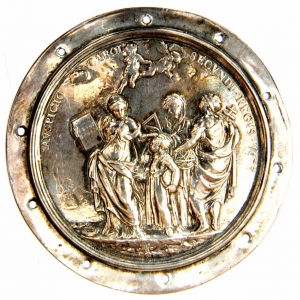An A to Z of the Chiswick House Archives: P is for Potter
In the latest in our A-Z series, volunteer archivist Cluny Wells shares the story of Peter Potter of Walsall and Chiswick Fame.
Early Life and Education
Peter Potter, surveyor and cartographer, was born on the 10th August 1773 in Sherborne Lane, in the City of London. His father, John Potter, also had a small country house in Walworth. Peter was the only son of his father’s second marriage to a much younger wife, Sarah Muggeridge, but Sarah unfortunately died when Peter was only 8 years old.
As the child of an older parent he was idolised and indulged by his father, who also believed he was very clever. Because of John Potter’s advanced age and Peter’s youth he bought him a place at Christ’s Hospital School, as a boarder, in Hertford to ensure his protection in case he died before Peter could be his own guardian. Hertford was where the junior pupils attended and lived and later on Peter was transferred to the London branch of the school. Being there meant that father and son were now in the same town, so could meet and communicate more easily than before, and his father was able to arrange for him to receive extra rations, as other fortunate boys had – such as a delicious hot buttered roll brought each morning after breakfast, delivered by a local baker.
Those boys, getting these extras, were known as ‘Roll Boys’. Peter displayed an excellency for Mathematics, and did so well that he was promoted to be a ‘King Charles Scholar’ – part of an elite group of 40 mathematical scholars at Christ’s Hospital being trained as Midshipmen for the King’s Navy or the East India Company.


Sea Faring Life
He started his appointment in 1790 with the East India Company, after having passed his entrance exams with credit, and his ship was the ‘Woodford’, captained by Charles T. Lennox. He was valued by his superior officers so much that he was tasked with the care of the ship’s log books. Peter’s first voyage was to Calcutta. On his second voyage to the East Peter was on the Pigot, again an East India Company ship, when they were attacked by a French man-of-War. The Pigot crew disabled the French ship, but the Pigot was badly hurt, and before there was time to repair it the crew were taken prisoner, and taken to the Isle of Mauritius. They were treated well as prisoners until it was known that the French prisoners taken by the British, were not being treated well. Peter and his companions were placed in more harsh conditions, with little food, and they felt fear of the guillotine being erected within earshot. Luckily exchanges of prisoners on both sides were arranged and Peter returned to Britain.

Marriage and Career on Land
By the time Peter’s time as a midshipman had run its course, ‘love’ had stepped in. About to be promoted as a Lieutenant in the East India Company, he had met the young woman he wished to marry, but she, an Elizabeth Mitchell, would not agree to marry a sea-faring man. Peter then arranged to train as a civil engineer with a Mr Graeme in London, where he met Mr Heaton, an agent of the Duke of Devonshire. Mr Heaton, impressed by the work and character of Peter Potter, and after Peter’s articles were completed, requested him to do an important and extensive survey of one of the Duke’s estates connected with planning and constructing roads on this estate.
Potter and Elizabeth Mitchell married in the Parish Church of Southwark and settled in Bermondsey – which was in the fields in those days – not too far from her parents in Southwark. Peter’s work then necessitated the couple move to Paddington, where their eldest child Elizabeth was born in 1800. From there they moved on to Kentish Town where their remaining five children were born. There was a temporary move to Yorkshire six years later, as Peter had work in that area. During his time there he produced surveys for twenty-five maps of many farms and estates in the Derbyshire area, almost exclusively for the Devonshire family.
The Potter family returned to Kentish Town to live by1807, even though Peter worked on the Derbyshire maps for a further seven years. During this time he surveyed and produced the well known 1818 map of Chiswick House and Grounds and the surrounding lands belonging to the 6th Duke of Devonshire. This map is known as ‘Potter’s Map’.

The Pineapple and the Elephant
When Elizabeth, Potter’s eldest, was 16 he took her with him to Chiswick where he had a day’s work to do for the Duke, probably connected to the survey of the Chiswick’s grounds. He left her in the care of the Housekeeper. From this point on I shall quote Elizabeth’s own words on her day from her Reminiscences:
My father, …….took me with him, and put me in the care of the housekeeper with a request that, as the family were absent, she would show me the paintings and other valuable works of art which the house contained, and with these I was highly delighted. She had an elegant little dinner provided for us, the dessert entirely from the hothouses belonging to the mansion, and I then tasted pineapple for the first time. The housekeeper then said (almost as an afterthought) ‘Do you think Miss Potter would like to ride on the elephant?’ Of course Miss Potter would, and the keeper brought it out. It had a Morocco gilt saddle with a seat like a small howdah; at the keeper’s order it knelt down for me to be lifted on, and then my father and the keeper walking by the side, I rode as long as I wished, and the gentle animal at the word of command knelt down again for me to dismount. The keeper afterwards made him display many clever tricks, such as drawing water to drink, and unfastening the bin and helping himself to biscuits. This beautiful animal was sent as a present to the Duke from India, and he had a commodious building erected for him.

Elizabeth declared that the elephant ride, although exciting, was one incident in a very enjoyable day she had spent at Chiswick with her father.
The Potter family lived on in London until 1821 while Peter had plenty of work in London. Sometimes receiving payment for work though took time and could entail sending several letters with polite requests.
Below is a letter, the third of three Peter sent to Mr Currey the Duke’s agent, regarding late payments.

Later Life
Peter Potter was probably looking for more secure work with a more regular salary by the year of 1820, when he heard through Mr Pinder Simpson, another of the Duke of Devonshire’s agents that the Earl of Bradford was looking for a new Land Agent. Potter’s name was recommended by the agent and the appointment was made. A year later the Potter family moved up to the West Midlands to Knockin Hall in Shrewsbury – this was the official home of Lord Bradford’s Chief Agent.

Peter Potter and his family lived for a short while at Knockin Hall before moving to a newly built house – Gorway House, near Walsall – which was the family home until his death at the age of 70 on the 13th March 1843. His eldest son, also Peter, took over the Agency when he retired. Peter Potter (Snr) had what could have been a difficult start in life – losing his mother at a young age, with grown up step siblings. Of course Peter had a loving father who made sure he gave him a good and secure start. Peter loved his children, his relatives and friends. He supported family and friends when they needed help, and in turn was dearly loved by them. He had talent and skills in his chosen occupations, worked hard, and had well earned success in whatever he did. He seemed to enjoy his life to the full.

Sources used:
- Reminiscences of Elizabeth Kingston Neele, née Potter (1800-1884) written in 1874
- Wikipedia – image of boy (Constant Lambert) in school uniform of Christ’s Hospital, and an image of the silver badge worn by Potter as one of the elite Kings’ Scholars
- Image of East India Company ships in Deptford from 17th century – Maritime Museum, Greenwich
- Article by Peter Hammond about Peter Potter’s surveys, maps, and letters in Brentford & Chiswick Local History no.12, 2003
- Image of an Indian Elephant (like Sadi) with simple howdah
- Chiswick Local History Centre – a copy of Potter’s 1818 map
- Chatsworth Archives- image of letter from Potter to Duke of Devonshire’s Agent Mr Currey, and an image of Potter’s letter seal: By permission of the Devonshire Collections, Chatsworth.
- Shropshire Archives – image of Knockin Hall